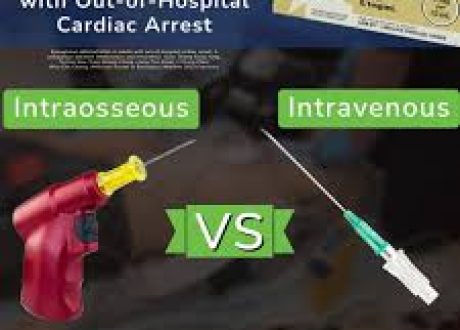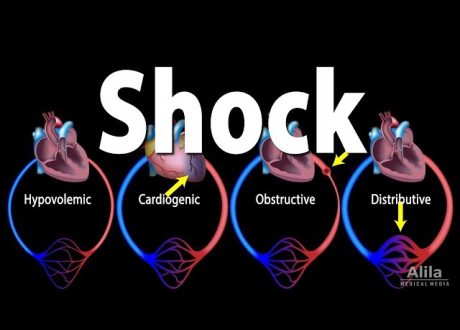Podcast: Play in new window | Download
Date: September 23, 2024
Reference: Essat et al. Diagnostic Accuracy of D-Dimer for Acute Aortic Syndromes: Systematic Review and Meta-Analysis. Annals of Emergency Medicine, May 2024
Guest Skeptic: Dr. Casey Parker is a Rural Generalist from Australia who is also an ultrasounder.
Case: You are working a busy shift in a rural emergency department (ED) and your excellent Family Medicine trainee presents a case of a 63-year-old woman with chest pain and some intermittent radiation into the inter-scapular region. The patient has no specific risk factors for acute coronary syndrome (ACS) or dissection. The history is not overly concerning for dissection – the adjectives “severe”, and “ripping” or “tearing” are not used.
Your trainee has done a great work-up and the possibility of an acute aortic dissection (AAD) is included in her differential diagnosis. Because this is a rural ED and the closest Computed tomography angiography (CTA) is a three-hour drive away, we must decide if this will benefit this patient.
You accompany your trainee back to the bedside and clarify the nature of the chest pain, re-examine the patient and review all the available clinical data. There are no abnormalities in the blood work, ECG, or chest x-ray. Her pain seems to have settled. In this woman with no specific features of an aortic dissection, can we use a D-dimer assay to rule out this serious diagnosis and avoid a long and costly transfer?
Background: Diagnosing acute aortic syndromes (AAS), which encompass life-threatening conditions like aortic dissection, intramural hematoma, and penetrating ulcers, can be challenging in the emergency department. These conditions typically present with nonspecific symptoms such as chest, back, or abdominal pain, and without early identification, they carry high morbidity and mortality. Aortic dissections are known for their rapid progression and the necessity for swift diagnosis and intervention.
 CTA is often the go-to imaging modality due to its high sensitivity and specificity for detecting AAS, but its routine use comes with risks—exposure to ionizing radiation and increased healthcare costs. In low-prevalence populations, over-reliance on CTA may be unwarranted.
CTA is often the go-to imaging modality due to its high sensitivity and specificity for detecting AAS, but its routine use comes with risks—exposure to ionizing radiation and increased healthcare costs. In low-prevalence populations, over-reliance on CTA may be unwarranted.
Emergency physicians have increasingly turned to the D-dimer test, a readily available blood test, to help rule out AAS and reduce unnecessary imaging. However, the effectiveness of D-dimer for diagnosing AAS remains debated due to variable test performance in different patient populations.
The American College of Emergency Physicians (ACEP) has a policy on thoracic aortic dissections. They asked: “In adult patients with suspected acute nontraumatic thoracic aortic dissection, is a negative serum D-dimer sufficient to identify a group of patients at very low risk for the diagnosis of thoracic aortic dissection?”
- Answer: “In adult patients with suspected nontraumatic thoracic aortic dissection, do not rely on D-dimer alone to exclude the diagnosis of aortic dissection.”
Clinical Question: What is the diagnostic accuracy of D-dimer for diagnosing acute aortic syndrome (AAS)?
Reference: Essat et al. Diagnostic Accuracy of D-Dimer for Acute Aortic Syndromes: Systematic Review and Meta-Analysis. Annals of Emergency Medicine, May 2024
- Population: Patients presenting to the ED with symptoms consistent with acute aortic syndromes, such as new-onset chest, back, or abdominal pain, syncope, or signs of perfusion deficit.
- Excluded: Patients with AAS following major trauma or as incidental findings, and studies using a case-control design.
- Intervention: D-dimer assay with variable cut-offs in trials but the primary analysis of trials using < 500 ng/ml.
- Comparison: The reference standard tests used for comparison included imaging modalities such as computed tomography angiography (CTA), ECG-gated CTA, echocardiography, magnetic resonance angiography, and confirmation through surgery or autopsy.
- Outcome:
- Primary Outcome: Diagnostic accuracy of D-dimer for identifying acute aortic syndromes, specifically sensitivity and specificity.
- Secondary Outcomes: Trials with other cut-off values from 240 ng/ml to 2110 ng/ml.
Type of Study: A systematic review and meta-analysis of diagnostic cohort studies including prospective and retrospective data.
Authors’ Conclusions: “D-dimer concentration has high sensitivity (96.5%) and moderate specificity (56.2%) for acute aortic syndrome, with some uncertainty around estimates due to risk of bias and heterogeneity.”
 Quality Checklist for Systematic Review Diagnostic Studies:
Quality Checklist for Systematic Review Diagnostic Studies:
- The diagnostic question is clinically relevant with an established criterion standard. Yes
- The search for studies was detailed and exhaustive. Yes
- The methodological quality of primary studies were assessed for common forms of diagnostic research bias. Yes
- The assessment of studies were reproducible. Yes
- There was low heterogeneity for estimates of sensitivity or specificity. Yes and No
- The summary diagnostic accuracy is sufficiently precise to improve upon existing clinical decision-making models. Unsure
- Who funded the trial and were there any conflicts of interest (COIs): The funding and COIs were not specified.
Results: The mean age ranged from 53 to 63 years, and studies included a mixed-gender population.
Key Result: The D-dimer test demonstrated a high sensitivity and moderate specificity for diagnosing acute aortic syndromes.
- Primary Outcome: For studies using the 500ng/ml cut-off
- Sensitivity was 96.5% (95% credible interval [CrI] 94.8% to 98%)
- Specificity was 56.2% (95% CrI, 48.3% to 63.9%).
- The likelihood ratio for a positive test was 2.21 (95% CrI: 1.88 to 2.65),
- The likelihood ratio for a negative result was 0.06 (95% CrI: 0.04 to 0.09).
This is very similar to the test characteristic for D-Dimer in the investigation of pulmonary embolism.
- Risk of Bias:



Spectrum Bias
1. Disease Spectrum: The studies included patients with “acute aortic syndrome” which is a blanket term including traditional dissection, intramural hematoma and penetrating atherosclerotic ulceration. As a clinician, I am interested in excluding the immediate life threat – that is a type A dissection. By including these other disease entities as “true positives” it may make the sensitivity appear better than it would be if we only counted “acute aortic dissection” as a positive.
This is akin to finding a bunch of sub-segmental pulmonary embolisms (PEs) and grouping them with a few saddle PEs and combining all these as “true positives”. Your test will look more sensitive, but will it detect a disease that may not be clinically important?
2. How Sensitive is Good Enough? To answer this question, we need to consider the badness of the disease, the risks of overdiagnosis and the available interventions. True aortic dissection is a bad disease with high mortality. Surgery is good in these cases with the long-term survival rates in the 80% range. Therefore, we can say this is a disease worth identifying, and we should demand a very high sensitivity to exclude AAD.
This is a subjective call but 96% might not be good enough. For other serious diseases, e.g. a subarachnoid hemorrhage we get up to 99+%. Every clinician and patient will have a different risk tolerance, and they would consider being a sensitive enough test.

Thomas Bayes
3. BAyes – It’s All About the Bayes: The key to diagnostic tests is to have a clear understanding of pre-test probability before applying a test such as a D-dimer. The likelihood ratios presented here are useful: if we know that the -LR is 0.06 and if we decide that we will accept a 1% post-test probability then we can only be happy to use a D-dimer in patients where we have a 20% or less pre-test probability of dissection. That population may be hard to define as it is a clinically dichotomous presentation.
If a patient uses the terms “tearing” or “severe” we are probably already well over that threshold. However, typically we use our gestalt to decide who is so low risk that history and exam are enough to place them in a “go home” group.
4. Imaging Efficiency: The role of D-dimer is to decide who gets a CT and who does not. Unfortunately, this paper shows a wide range of specificities. The pooled specificity in this analysis had specificity in the “coin toss range” and this could result in an increase in imaging with no patient-important benefits.
We have seen examples in the past (e.g. The Canadian Assessment of Tomography for Childhood Head Injury [CATCH]) where such a clinical decision tool increased the imaging without improving outcomes. We just may be shooting ourselves in the foot here. It may be that clinical gestalt is as good to decide who we don’t send the patient to the “donut of truth” (CT scanner). It would require a real-world validation trial to measure the efficiency and patient-oriented outcome (POO) of benefits that D-Dimer may / or may not add in the workup of AAS.
 5. Heterogeneity in the Populations: Sometimes just looking at the baseline is all we need to know. When it comes to pre-test probability, we can look at the actual pick-up rates in the study to get a feel for how dilute (prevalence) the disease was in that population. In other words, which patients were considered risky enough to include in each cohort? There is a wide range of prevalence across countries and studies. One Japanese study included 65% of patients with the disease. In contrast, a UK cohort had only a 1% rate of AAS (this was a clear outlier). However, it is important to include all the available trials and not “cherry-pick” with results that seem tight and precise.
5. Heterogeneity in the Populations: Sometimes just looking at the baseline is all we need to know. When it comes to pre-test probability, we can look at the actual pick-up rates in the study to get a feel for how dilute (prevalence) the disease was in that population. In other words, which patients were considered risky enough to include in each cohort? There is a wide range of prevalence across countries and studies. One Japanese study included 65% of patients with the disease. In contrast, a UK cohort had only a 1% rate of AAS (this was a clear outlier). However, it is important to include all the available trials and not “cherry-pick” with results that seem tight and precise.
Pooling data from these different patient groups is difficult and can make it harder to inform our practice. Our local culture and risk tolerance are likely not represented by many of these trials.
Comment on Authors’ Conclusion Compared to SGEM Conclusion: These numbers are derived straight from the data – so it’s hard to argue. However, I agree with the authors’ discussion points: “It is not clear whether D-dimer is best targeted at low or moderate-risk patients. European guidelines suggest using D-dimer in patients with a low risk of acute aortic syndrome, but this could lead to indiscriminate use of D-dimer in patients at negligible risk and a consequent increase in negative imaging.”
SGEM Bottom Line: It remains unclear as to the role of D-Dimer testing in patients with suspected acute aortic syndrome. Whilst this paper provides good data on the test characteristics of D-dimer for AAS – it cannot inform our application in the clinical setting.
Case Resolution: Clinically your gestalt says that this is not a dissection. You enter a shard-decision-making discussion with the woman and her husband. You let her know that her acute coronary syndrome and pulmonary embolism risks are low and that she has a small but NON-ZERO risk of aortic disease. A blood test called a D-dimer may further lower this risk, however there is a good chance it will return a false positive and muddy the waters. She feels reassured after the counselling and decides not to pursue future investigation and is happy to go home with appropriate instructions about returning if her symptoms return or change.

Dr. Casey Parker
Clinical Application: D-dimer testing is a sensitive but non-specific marker of acute aortic syndromes. It may have a role in the risk stratification of patients with intermediate risk of aortic dissection on clinical assessment. Further study of the real-world outcomes of algorithms using D-dimer is required before we use it as a one-way tool in ED practice.
What Do I Tell the Patient? We are happy to hear that your pain has resolved and at this time we feel that further investigation will not benefit you. Please do not hesitate to return if your symptoms return or if you have other concerns.
Keener Kontest: Last week’s winner was Dr. Michael Zelenetz. He knew the stage name of the singer in the 1999 movie “Bring out the Dead” who was resuscitated with naloxone was I.B. Bangin, otherwise known as Fredrick (not Fred or Freddy) Smith.










